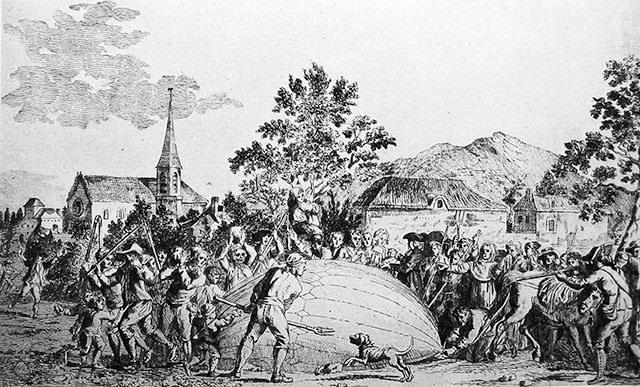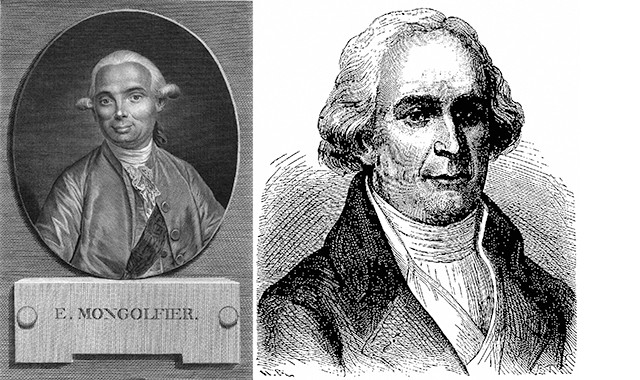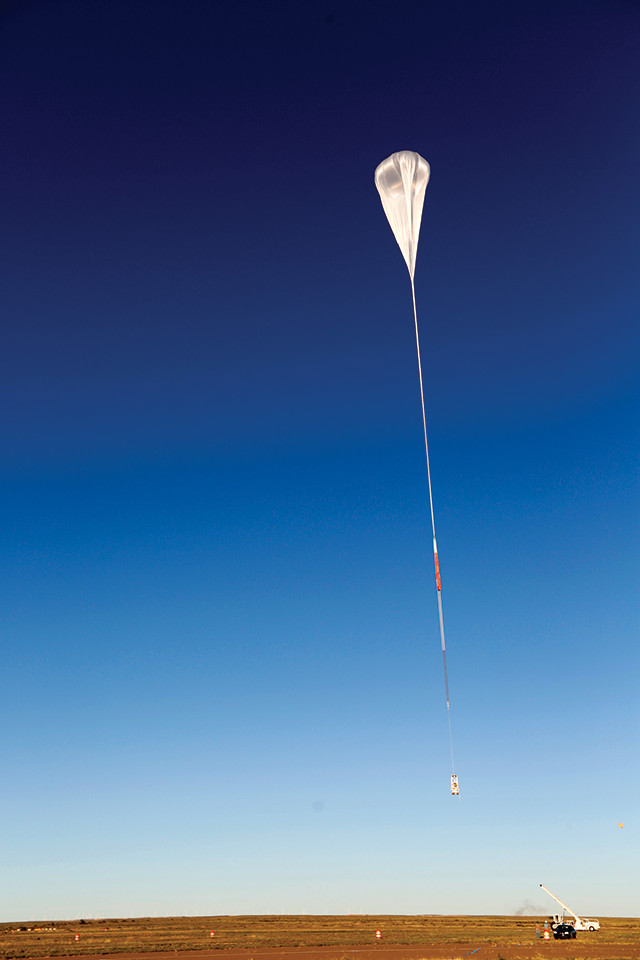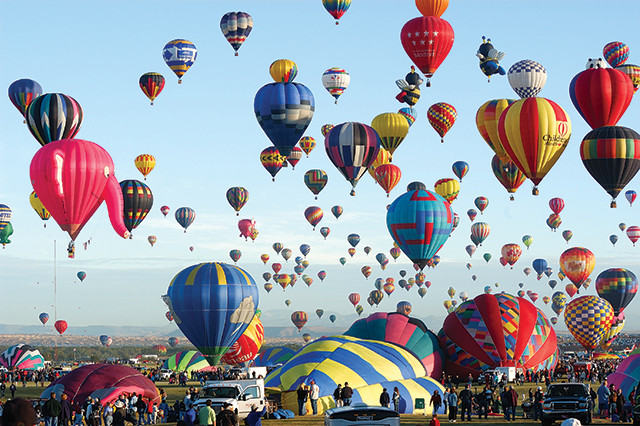
by Lucas Joel Thursday, May 26, 2016

A crowd of peasants attacked the first hydrogen balloon in Gonesse, France, in August 1783. Credit: public domain.
In the small French town of Gonesse in August 1783, a large, spherical and nebulous object painted with red and yellow stripes fell from the sky and began fluttering about on the ground. The town’s peasants, fearful, attacked the object with pitchforks, and then tied it to a horse’s tail to be dragged through the streets.
The invader, it was later discovered, was Le Globe — the first hydrogen-powered balloon. Le Globe’s inventor, French scientist Jacques Charles, had built it shortly after two French brothers, Joseph-Michel and Jacques-Étienne Montgolfier, had launched the first public hot-air balloon only a few months earlier on June 4.

Two brothers, Jacques-Étienne (far left) and Joseph-Michel Montgolfier (left), are credited with the first hot-air balloon launch. Credit: public domain.
" — which describes the relationship between the temperature and volume of a gas — is named; Benjamin Franklin, who was the United States ambassador to France; and the French king, Louis XVI. Balloons soon rose to prominence, and in the ensuing centuries they have been used as tools of war, instruments of weather forecasting and atmospheric research, and vehicles for recreation, sporting and tourism.
The Montgolfier brothers, who were papermakers by trade, were not the first to employ the properties of buoyant warm air for flight. That distinction likely belongs to inventors in China and other Southeast Asian countries who were “probably flying balloons in antiquity, albeit small balloons — essentially the kind of Japanese paper lanterns that we fly sometimes today,” says Tom Crouch, senior curator of aeronautics at the Smithsonian’s National Air and Space Museum.
So why did it take until the late 18th century for balloons — at least those that could carry humans — to be invented? “Ancient peoples built relatively lightweight fabric, and everybody knew that smoke rises, so why didn’t the ancient Egyptians, or the Babylonians, or the Mayans build balloons?” Crouch asks. The likely answer, he says, is that the balloon idea simply never occurred to them, as flight in nature tends to be done by creatures that are, unlike balloons, heavier than the air around them.
Things changed, though, during the scientific revolution, which in 1766 saw the discovery of hydrogen gas by Henry Cavendish, who referred to it as “flammable air.” People “recognized that, ‘Here we have a gas that’s six times lighter than ambient air. If we fill some kind of a lightweight vessel with this stuff, maybe it’ll fly,’” Crouch says. You can just imagine “light bulbs going off over heads all over Europe.”
By the time they began experimenting, the Montgolfier brothers knew about hydrogen, but they lacked the impermeable materials needed to harness it; before turning to hot air, they had tried filling a paper balloon with hydrogen, but the gas leaked out. So, the brothers turned to what they themselves had dubbed Montgolfier gas — something they thought was another buoyant gas like hydrogen, but which was simply hot air produced by burning organic matter.
Rozier_publicdomain.png" caption=“Illustrations depicting the first hot-air balloon flight (left), in Annonay, France, on June 4, 1783, and the first balloon flight with human passengers (right) in November 1783. Credit: both: public domain.” >}}
“The first unmanned balloon, launched by the Montgolfiers using hot air, took off from a square in Annonay in southern France on June 4, 1783. The balloon was about 11 meters in diameter horizontally, made of cotton lined with paper, and weighed about 230 kilograms. While too small to carry a person, the launch nonetheless marked the birth of aviation, and the news quickly reached Paris.
Charles soon constructed Le Globe, which he launched from the Champs de Mars — close to where the Eiffel Tower now stands — and, in September that same year, the Montgolfiers launched another balloon, this one for the French king and queen, Louis XVI and Marie Antoinette, at the Palace of Versailles. This time, the balloon carried the first living creatures aloft.

Launch of a NASA balloon from the Columbia Scientific Balloon Facility in New Mexico. Credit: NASA/JHU APL.
At first, the king suggested a criminal be used for the first launch. But, Crouch says, a man named Jean-François Pilâtre de Rozier is said to have objected, suggesting the king not “give the honor of being the first human being to fly to a convict.” Of course, it was also not known what sort of effects flight might have on the human body. “People had climbed mountains, [so] they knew that when you got higher than this balloon was ever going to go, there was still stuff to breathe,” Crouch says. What was not so clear, though, was whether the atmosphere — at least one in which humans could survive — only stretched a certain height above the ground, regardless of where one stood on Earth.
The first three aviators, then, would be a sheep named Montauciel, which means “climb to the sky,” a rooster and a duck. The choice of these animals was not random. The sheep most closely resembled a human, anatomically speaking, whereas the rooster and duck represented animals more naturally adapted to flight. If there were to be any adverse side effects to flying, the thinking was that Montauciel, and perhaps the flightless rooster, would likely incur them.
On Sept. 19, 1783, in front of a large crowd at Versailles, including the king and queen, the animals rose off the ground, carried by a blue balloon decorated with brightly colored designs, including suns, zodiac signs and royal symbols. The balloon, carrying the animals in a hanging basket, drifted for about eight minutes over 3 kilometers or so. “The people who were at Versailles chased the balloon on horseback,” Crouch says. “De Rozier was the first guy to reach the balloon when it landed, and he discovered that the animals were OK.”
A few months later, in November, de Rozier, along with a French marquis named François Laurent d’Arlandes, climbed into another Montgolfier balloon, this time at the Chateau de la Muette near Paris in front of a large crowd that included Benjamin Franklin. The balloon took off, traveled about 8 kilometers in 25 minutes, and carried the first human aviators into history.
ured imaginations, but the future of balloons, and how they would eventually come to be used, was unclear. When Charles launched Le Globe in August 1873, Benjamin Franklin, who was watching the event from his carriage, purportedly overheard someone in the crowd question the usefulness of such a flying object, Crouch says, to which Franklin is said to have responded, “Sir, what use is a newborn babe?”
Franklin, the statesman-scientist, immediately recognized the military potential of balloons. During the French Revolution as well as during the American Civil War, military balloon corps were used to support infantry. “In a battle, the higher you are, the better off you are because you can see what the other guy is doing behind his lines,” Crouch says.

Balloons lifting off at Albuquerque's annual Balloon Fiesta. Credit: a4gpa, CC BY-SA 2.0.
© 2008-2021. All rights reserved. Any copying, redistribution or retransmission of any of the contents of this service without the expressed written permission of the American Geosciences Institute is expressly prohibited. Click here for all copyright requests.